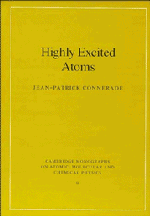Book contents
- Frontmatter
- Contents
- Preface
- 1 Closed shells, sphericity, stability and ‘magic numbers’
- 2 Rydberg states
- 3 Quantum defect theory for bound states
- 4 Atomic f values
- 5 Centrifugal barrier effects
- 6 Autoionisation
- 7 Inner-shell and double-excitation spectra
- 8 K-matrix theory of autoionising resonances
- 9 Atoms in strong laser fields
- 10 Statistical methods and ‘quantum chaology’
- 11 Atomic effects in solids
- 12 Atomic clusters
- References
- Index
7 - Inner-shell and double-excitation spectra
Published online by Cambridge University Press: 19 September 2009
- Frontmatter
- Contents
- Preface
- 1 Closed shells, sphericity, stability and ‘magic numbers’
- 2 Rydberg states
- 3 Quantum defect theory for bound states
- 4 Atomic f values
- 5 Centrifugal barrier effects
- 6 Autoionisation
- 7 Inner-shell and double-excitation spectra
- 8 K-matrix theory of autoionising resonances
- 9 Atoms in strong laser fields
- 10 Statistical methods and ‘quantum chaology’
- 11 Atomic effects in solids
- 12 Atomic clusters
- References
- Index
Summary
Introduction
Many-electron atoms differ from H in an essential respect: when they are excited up to and above the first ionisation potential, they exhibit structure which is not simply due to the excitation of one valence electron. The clearest manifestation of this behaviour occurs in the ionisation continuum. For H, the continuum is clean, i.e. exempt from quasidiscrete features. In any many-electron atom, there will be autoionising resonances of the type discussed in chapter 6. Autoionisation is therefore a clear manifestation of the many-electron character of nonhydrogenic atoms.
In the present chapter, the questions: why does this extra structure occur and how does one set about interpreting it? are addressed. Thus, we will not be so concerned about the lineshapes or even (in first approximation) about interseries perturbations (although they do turn out in some cases to play a crucial role), but rather with the configurations of the inner-shell and doubly-excited states, and their relation in energy to the valence spectrum.
Inner-shell excitation
Even within the independent electrom approximation, it is obvious that there must exist inner-shell excitation spectra, and that their energy must extend well above the first ionisation potential. This arises from the simple fact that one can choose which electron is excited: it does not necessarily have to be the valence electron, and the inner electrons, being more strongly bound, require photons of higher energy to excite them.
- Type
- Chapter
- Information
- Highly Excited Atoms , pp. 218 - 245Publisher: Cambridge University PressPrint publication year: 1998



